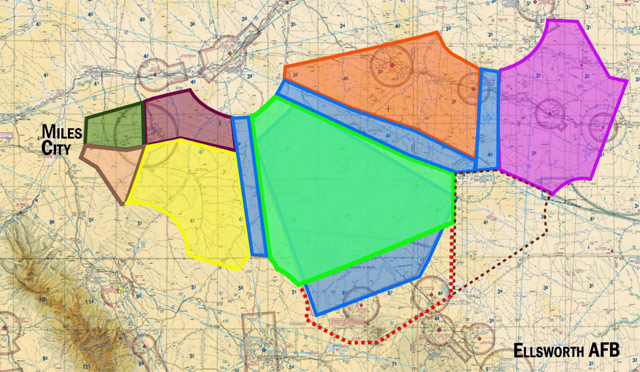Powder River environmental statement finalized
GA concerns largely overlooked
 The U.S. Air Force has released its final environmental impact statement for an enormous military airspace complex that includes Wyoming, Montana, North Dakota, and South Dakota. But the environmental statement, released Nov. 28, does not address concerns about the safety and economic impacts of the proposed Powder River Training Complex on general aviation operations in Montana.
The U.S. Air Force has released its final environmental impact statement for an enormous military airspace complex that includes Wyoming, Montana, North Dakota, and South Dakota. But the environmental statement, released Nov. 28, does not address concerns about the safety and economic impacts of the proposed Powder River Training Complex on general aviation operations in Montana.
“We are concerned that the Air Force has chosen not to make accommodations for general aviation operators in its final environmental impact statement,” said Melissa Rudinger, AOPA vice president of government affairs. “We will continue to work with all parties involved to help find ways to improve the operation of the airspace and minimize the economic consequences associated with this military training area.”
The Powder River Training Complex, which consists of four primary military operations areas (MOAs) connected by Gap MOAs, would affect 39 airports, creating operational challenges for both VFR and IFR flights at altitudes from 500 feet agl up to the flight levels. The expanded Powder River Training airspace complex would be used for an estimated 2,882 training hours each year, compared to the 1,249 training hours conducted in the existing airspace annually. The military estimates it would use the airspace three-to-six hours per day, about 240 days per year.
On behalf of its members in Montana and other affected states, AOPA has sought changes that would make parts of the Powder River Training Complex more accessible to both VFR and IFR general aviation traffic and provide better notice of military exercises to GA pilots. These include reducing charted times for primary MOAs and making Gap MOAs temporary; establishing a special-use airspace information service to provide civilian pilots with real-time information about military flight operations; allowing real-time access to airspace for IFR flights; and eliminating the Powder River 3 Low MOA, or at least activating it only by notam.
Unfortunately, the Air Force’s final environmental impact statement did not address these mitigations.
“We very much respect the military’s need to train, but we also recognize the potential economic impact and the importance of keeping civil aviation safe, especially in the heavily impacted airspace of Montana,” said Rudinger. “And that’s why we will continue to work with government agencies and affected pilots to address these issues as the airspace proposal moves to the next stage.”
The FAA will now assess the environmental impact statement and other factors before the airspace changes are finalized.



